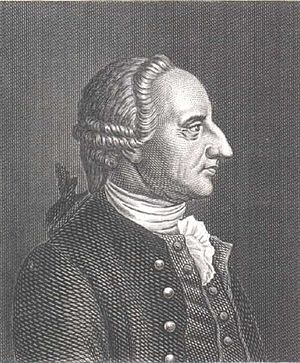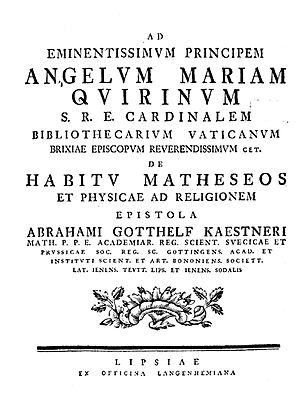Abraham Gotthelf Kästner facts for kids
Quick facts for kids
Abraham Gotthelf Kästner
|
|
|---|---|

Abraham Gotthelf Kästner
|
|
| Born | 27 September 1719 Leipzig, Electorate of Saxony
|
| Died | 20 June 1800 (aged 80) Göttingen, Duchy of Brunswick-Lüneburg
|
| Nationality | German |
| Education | University of Leipzig (Dr. phil. hab., 1739) |
| Scientific career | |
| Fields | Mathematics |
| Institutions | University of Leipzig University of Göttingen |
| Thesis | Theoria radicum in aequationibus (1739) |
| Doctoral advisor | Christian August Hausen |
| Doctoral students | Johann Friedrich Pfaff Georg Christoph Lichtenberg Johann Tobias Mayer Heinrich Wilhelm Brandes Johann Christian Polycarp Erxleben |
| Other notable students | Farkas Bolyai Johann Christian Martin Bartels |
Abraham Gotthelf Kästner (born September 27, 1719 – died June 20, 1800) was a German mathematician and a writer of short, witty poems called epigrams.
He was well-known for writing many textbooks and putting together encyclopedias. He was not as famous for new discoveries in math. One of his students, Georg Christoph Lichtenberg, admired him a lot. Kästner became most famous for his clever poems. There is even a crater on the Moon named Kästner after him!
Contents
Who Was Abraham Kästner?
Early Life and Education
Abraham Kästner was born in Leipzig, Germany. His father was a law professor. From 1731, Abraham studied many subjects at the University of Leipzig. These included law, philosophy, physics, mathematics, and metaphysics.
He became a Notary in 1733. In 1739, he earned his qualification to teach at the University of Leipzig. He then gave lectures there on mathematics, philosophy, logic, and law. By 1746, he became an associate professor.
His Family Life
In 1757, Kästner married Anna Rosina Baumann. They had been engaged for 12 years. Sadly, Anna died less than a year later, in March 1758, from a lung illness. Kästner later had a daughter named Catharine.
Teaching and Students
In 1751, Kästner was chosen to be a member of the Royal Swedish Academy of Sciences. He moved to the University of Göttingen in 1756. There, he became a full professor of natural philosophy (science) and geometry.
In 1763, he also became the director of the observatory. This happened after Tobias Mayer passed away. Many famous students studied with Kästner. These included Georg Christoph Lichtenberg, who later became his colleague. Other important students were Johann Christian Polycarp Erxleben and Johann Pfaff. Johann Pfaff was even the teacher of the famous mathematician Carl Friedrich Gauss.
Kästner passed away in Göttingen in 1800.
What Did He Do?
His Witty Poems
Kästner became very well known for his poems. They were first printed in 1781 without his permission. These poems were famous for their clever humor and sharp, sometimes sarcastic, comments about people of his time.
His poems were published in collections like Vermischten Schriften (1783). More poems were later included in Gesammelten poetischen und prosaischen schönwissenschaftlichen Werken (1841).
Math Books and Translations
Kästner wrote many books about mathematics. One of his important works was Anfangsgründe der Mathematik (which means "Foundations of Mathematics"). This book was published in four volumes between 1758 and 1769.
He also wrote a four-volume book called Geschichte der Mathematik ("History of Mathematics"). This work is seen as very smart. However, it doesn't cover all parts of mathematics in a complete way.
Kästner also translated many reports from the Royal Swedish Academy of Sciences into German. He translated all the volumes of their Proceedings from 1749 to 1781. He also translated some of their New Proceedings from 1784 to 1792.
In April 1789, he was elected a Fellow of the Royal Society. This is a very respected group of scientists.
[Abraham Gotthelf Kästner is] the best mathematician among poets and the best poet among mathematicians.
—Carl Friedrich Gauss, quoted in Morris Kline, Mathematics and the Physical World (1959) Ch. 26: Non-Euclidean Geometries, p. 444. Gauss meant it as a sarcastic remark, after he presented his construction of the 17-gon, and Kästner failed to notice its significance.
This quote from the famous mathematician Carl Friedrich Gauss might sound like a compliment. But Gauss actually meant it as a joke. He said it because Kästner was good at poetry but didn't always understand the importance of new math ideas.
See also
 In Spanish: Abraham Gotthelf Kastner para niños
In Spanish: Abraham Gotthelf Kastner para niños


